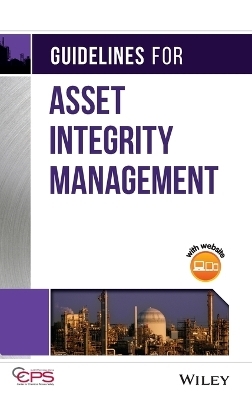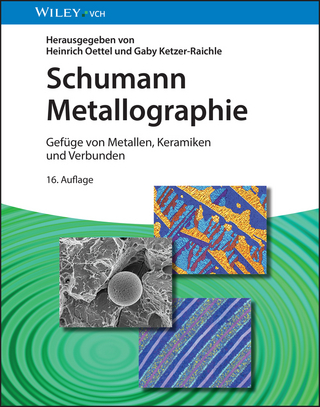
Guidelines for Asset Integrity Management
Wiley-AIChE (Verlag)
9781119010142 (ISBN)
Since 1985, the Center for Chemical Process Safety (CCPS) has been the global leader in developing and disseminating information on process safety management and technology. CCPS, an industry technology alliance of the American Institute of Chemical Engineers (AIChE), has published over 100 books in its process safety guidelines and process safety concepts series, and over 100 training modules through its Safety in Chemical Engineering Education (SACHE) series.
List of Figures xi
List of Tables xiii
Preface xvii
Acknowledgments xix
Files on the Web xxi
1 Introduction 1
1.1 Background and Scope 1
1.2 What is Asset Integrity Management? 2
1.3 What Assets are Included? 5
1.4 AIM Life Cycle 7
1.5 Relationship to Other Programs 7
1.6 Relationship to RAGAGEP 8
1.7 Structure of this Document 12
Chapter 1 References 15
2 Management Responsibility 17
2.1 Leadership Roles and Responsibilities 17
2.2 Technical Assurance Responsibilities 25
Chapter 2 References 29
3 AIM Life Cycle 31
3.1 Overview 31
3.2 Research Through Process Development 33
3.3 Process Design 35
3.4 Engineering, Procurement and Construction 39
3.5 Commissioning 40
3.6 Operation and Maintenance 42
3.7 Decommissioning 44
3.8 RAGAGEP Selection and Application at Each Stage 45
Chapter 3 References 47
Appendix 3A. Design Review Suggestions 49
4 Failure Modes and Mechanisms 53
4.1 Introduction 53
4.2 Equipment Functions and Functional Failure 54
4.3 Failure Modes 57
4.4 Damage Mechanisms 61
4.5 Failure Effects 64
4.6 Risk 65
4.7 Analysis 66
4.8 ITPM Task Assignments 69
4.9 Operational Issues 69
4.10 Other Related Activities 70
Chapter 4 References 70
Appendix 4A. Risk Concepts Related to AIM 73
5 Asset Selection and Criticality Determination 77
5.1 Program Objectives and Philosophy 77
5.2 Asset Selection Criteria and Principles 79
5.3 Level of Detail 84
5.4 Asset Criticality Determination 86
5.5 Documentation 96
5.6 Roles and Responsibilities 97
Chapter 5 References 99
Appendix 5A. Sample Guidelines for Selecting Assets for an AIM Program 100
6 Inspection, Testing and Preventive Maintenance 105
6.1 ITPM Task Planning 107
6.2 ITPM Task Execution and Monitoring 128
6.3 ITPM Program Roles and Responsibilities 137
Chapter 6 References 141
Appendix 6A. Common Predictive Maintenance and Nondestructive Testing (NDT) Techniques for Mechanical Equipment 142
7 Established Approaches for Developing Test and Inspection Plans 171
7.1 Code/Standard Approaches 171
7.2 Regulatory Authority Approaches 172
7.3 Company-Specific Approaches 172
7.4 Risk-Based Inspection (RBI) 173
7.5 Failure Modes, Effects and Criticality Analysis Approaches 176
7.6 Safety Instrumented Systems 179
Chapter 7 References 184
8 AIM Training and Performance Assurance 187
8.1 Skills and Knowledge Assessment 189
8.2 Training For New and Current Workers 191
8.3 Verification and Documentation of Performance Assurance 193
8.4 Certifications 194
8.5 Ongoing and Refresher Training 195
8.6 Training for Maintenance Technicians and Operators Performing Maintenance Tasks 197
8.7 Training for Technical Personnel 200
Contents ix
8.8 Contractor Issues 202
8.9 Roles and Responsibilities 203
Chapter 8 References 206
Appendix 8A. Sample Training Survey 207
Appendix 8B. Sample Training Guide 208
9 Asset Integrity Procedures 211
9.1 Types of Procedures Supporting the AIM Program 213
9.2 Identification of Needs 216
9.3 Procedure Development Process 220
9.4 Format and Content 223
9.5 Other Sources of AIM Procedures 226
9.6 Implementing and Maintaining AIM Procedures 227
9.7 AIM Procedure Program Roles and Responsibilities 229
Chapter 9 References 229
Appendix 9A. Example AIM Procedure 232
10 Quality Management 239
10.1 Design 241
10.2 Procurement 243
10.3 Fabrication 244
10.4 Receiving 246
10.5 Storage and Retrieval 247
10.6 Construction and Installation 248
10.7 In-service Repairs, Alterations and Rerating 250
10.8 Temporary Installations and Temporary Repairs 252
10.9 Decommissioning / Re-use 254
10.10 Used Assets 255
10.11 Spare Parts 256
10.12 Contractor-Supplied Assets and Materials 256
10.13 QA Program Roles and Responsibilities 257
Chapter 10 References 257
Appendix 10A. Sample Vendor QA Plan 260
Appendix 10B. Positive Material Identification 262
Appendix 10C. Sample Service Contractor QA Plan 266
11 Equipment Deficiency Management 269
11.1 Equipment Deficiency Management Process 270
11.2 Acceptance Criteria 270
11.3 Equipment Deficiency Identification 274
11.4 Responding to Equipment Deficiencies 275
11.5 Equipment Deficiency Communication 278
11.6 Tracking of Temporary Repairs 279
11.7 Deficiency Management Roles and Responsibilities 279
Chapter 11 References 280
12 Equipment-Specific Integrity Management 287
12.1 Vessels, Tanks and Piping 289
12.2 Relief and Vent Systems 294
12.3 Instrumentation and Controls 297
12.4 Rotating Equipment 300
12.5 Fired Equipment 303
12.6 Electrical Systems 304
12.7 Fire Protection and Suppression Systems 305
12.8 Ventilation and Purge Systems 306
12.9 Protective Systems 307
12.10 Passive Mitigation Systems 309
12.11 Solids-Handling Systems 310
12.12 Refrigeration Systems 311
12.13 Utilities 311
12.14 Safety Equipment 311
Chapter 12 References 314
Appendix 12A. Asset Integrity Activities by Equipment Type 317
13 AIM Program Implementation 383
13.1 Budgeting and Resources 383
13.2 Use of Data Management Systems 396
13.3 AIM Benefits and Return on Investment 400
Chapter 13 References 402
Appendix 13A. AIM Program Design Activity Worksheets 403
14 Metrics, Audits and Continuous Improvement: Learning from Experience 409
14.1 Performance Measurement and Monitoring 411
14.2 AIM Program and Implementation Audits 420
14.3 Continuous Improvement 427
Chapter 14 References 429
Appendix 14A. AIM-Related Regulatory Citations 430
15 Other Asset Management Tools 437
15.1 Introduction to Common Risk-based Analytical Techniques Used in AIM Programs 437
15.2 Incorporating Risk into AIM Decisions 443
15.3 Reliability-Centered Maintenance 445
15.4 Protection Layer Analysis Techniques 448
15.5 Asset Failure and Root Cause Analyses 451
Chapter 15 References 457
Acronyms and Abbreviations 459
Glossary 463
Index 469
| Sprache | englisch |
|---|---|
| Maße | 160 x 236 mm |
| Gewicht | 816 g |
| Themenwelt | Naturwissenschaften ► Chemie |
| Technik ► Maschinenbau | |
| ISBN-13 | 9781119010142 / 9781119010142 |
| Zustand | Neuware |
| Informationen gemäß Produktsicherheitsverordnung (GPSR) | |
| Haben Sie eine Frage zum Produkt? |
aus dem Bereich


